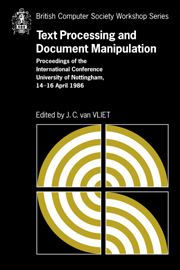 Text Processing and Document Manipulation
Text Processing and Document Manipulation Published online by Cambridge University Press: 05 May 2010
ABSTRACT
Computer text processing is still in the assembly-language era, to use an analogy to program development. The low-level tools available have sufficient power, but control is lacking. The result is that documents produced with computer assistance are often of lower quality than those produced by hand: they look beautiful, but the content and organization suffer. Two promising ideas for correcting this situation are explored: (1) adapting methods of modern, high-level program development (stepwise refinement and iterative enhancement) to document preparation; (2) using a writing environment controlled by a rule-based editor, in which structure is enforced and mistakes more difficult to make.
Wonderful Appearance–Wretched Content
With the advent of relatively inexpensive laser printers, computer output is being routinely typeset. It can be expected that there will be a revolution in the way business and technical documents are created, based on the use of low-cost typesetters. Easy typesetting and graphics is an extension of word-processing capability, which is already widespread. The essential feature of word processing is its ability to quickly reproduce a changed document with mechanical perfection. However, as the appearance improves, the quality of writing seems to fall in proportion. These forces are probably at work: (1) More people can (attempt to) write using better technology, and because writing is hard, novices often produce poor work. (2) With improved technology, projects are attempted that were previously avoided; now they are done, badly. These factors are familiar from programming, and suggest an analogy between creating a document and developing a program. The current word-processing situation corresponds to the undisciplined use of programming languages that preceded so-called “modern programming practices.”
To save this book to your Kindle, first ensure [email protected] is added to your Approved Personal Document E-mail List under your Personal Document Settings on the Manage Your Content and Devices page of your Amazon account. Then enter the ‘name’ part of your Kindle email address below. Find out more about saving to your Kindle.
Note you can select to save to either the @free.kindle.com or @kindle.com variations. ‘@free.kindle.com’ emails are free but can only be saved to your device when it is connected to wi-fi. ‘@kindle.com’ emails can be delivered even when you are not connected to wi-fi, but note that service fees apply.
Find out more about the Kindle Personal Document Service.
To save content items to your account, please confirm that you agree to abide by our usage policies. If this is the first time you use this feature, you will be asked to authorise Cambridge Core to connect with your account. Find out more about saving content to Dropbox.
To save content items to your account, please confirm that you agree to abide by our usage policies. If this is the first time you use this feature, you will be asked to authorise Cambridge Core to connect with your account. Find out more about saving content to Google Drive.